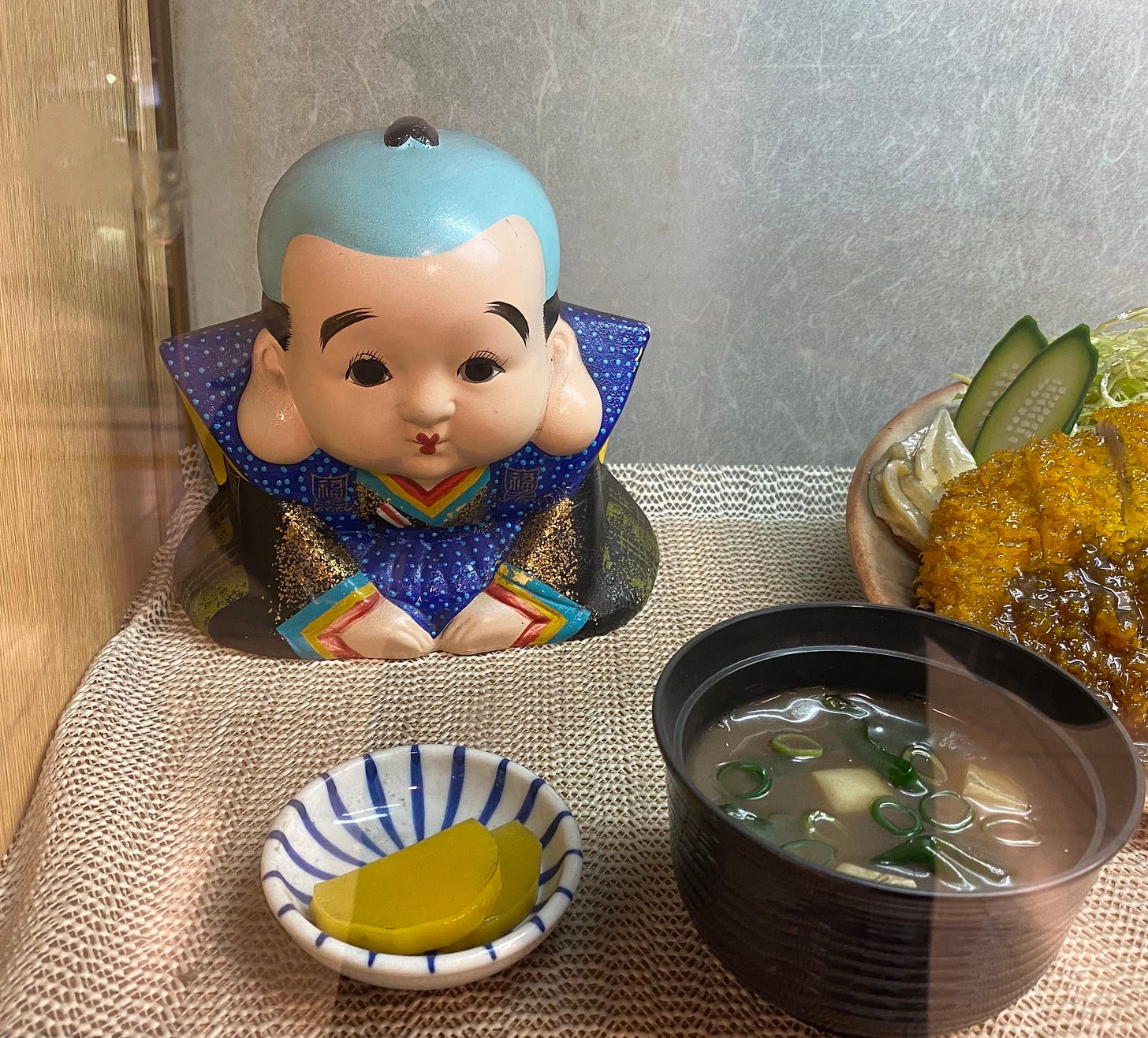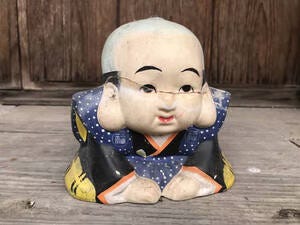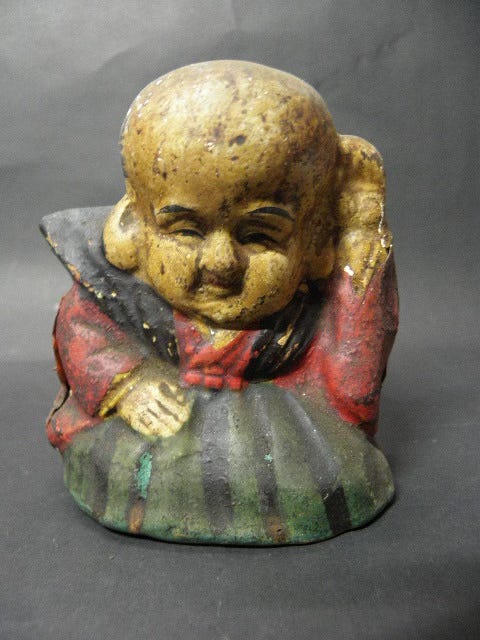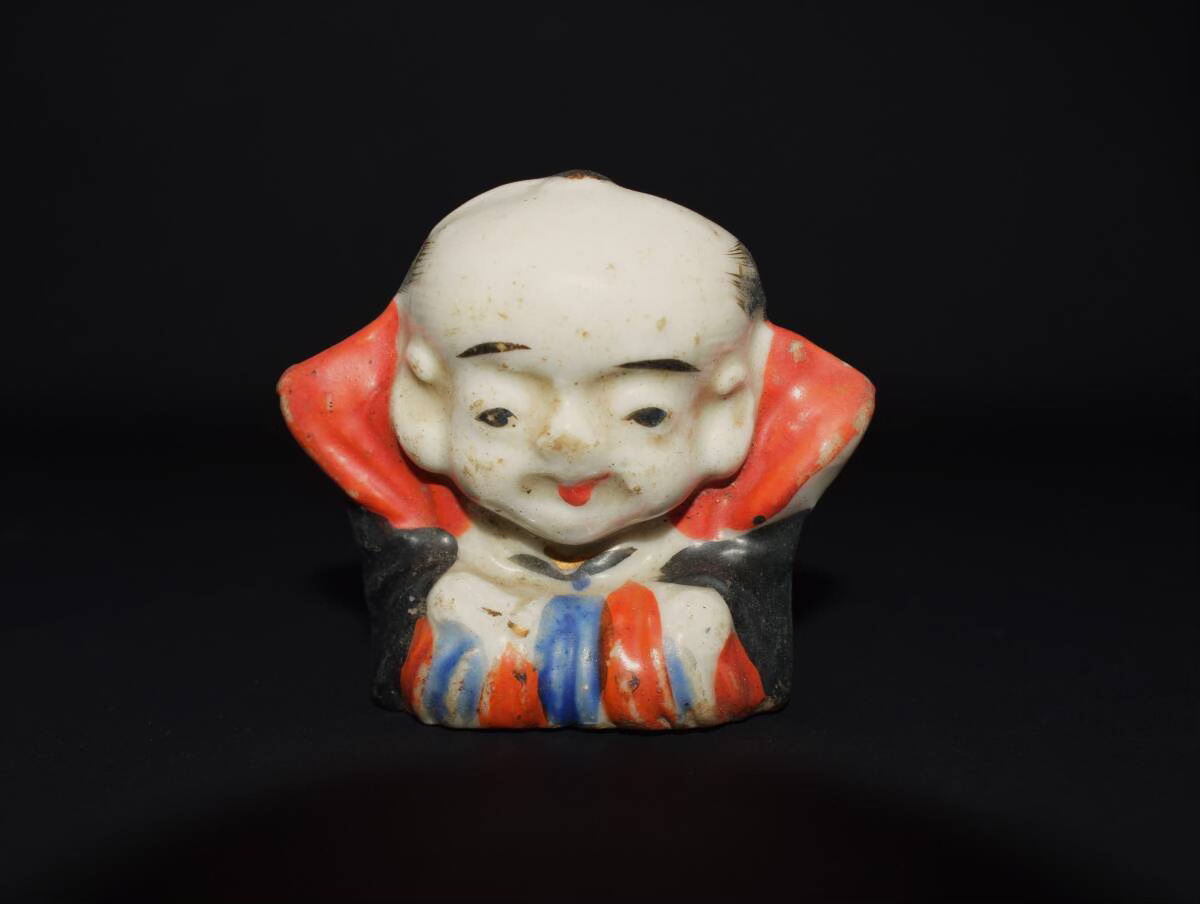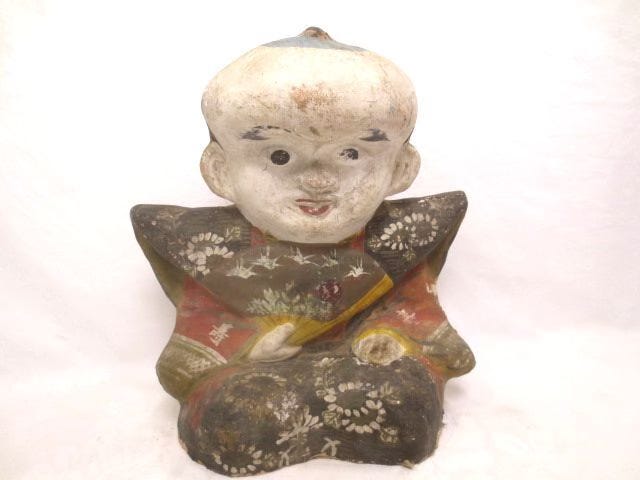Often traditional Japanese shops, restaurants and business establishments feature a small effigy of a smiling samurai like figure, kneeling in the seiza position, bowing his large, mostly shaven head, sporting a chonmage topknot hair style and wearing full kataginu, kamishimo and hakama, the formal attire of the samurai in the businesses window or reception area. These auspicious Fukusuke dolls are said to welcome customers and invite good fortune, these dolls were worshipped particularly in Edo period teahouses and brothels as a god capable of granting wishes and making dreams come true. It was once considered that having a Fukusuke in the home would bring perennial youth, wealth, happiness and honour.
It has been claimed that its roots are found in the deity of good luck or Fuku no Kami (福の神) also called Kano Fukusuke (叶福助) in the Edo period, but there are other theories about its origins. The doll usually wears a traditional kamishimo with exaggerated shoulders in the style of the samurai. While this kind of garment was indeed worn by the warrior class and court officials, some say that Fukusuke was based on a certain daimyo from Kyoto, but fail to mention who, or why. Kamishimo were also worn by certain entertainers, such as those seen performing for Noh and even Kabuki entertainments. It is thought that the original Fukusuke may not have been a warrior, but an entertainer.
In fact, the classic Beatles album, Sergeant Pepper's Lonely Hearts Club Band album cover also features a small Fukusuke figure to the lower left, and it is believed that this particular piece was purchased in Japan during the Beatles’ early July 1966 tour. The Beatles stayed in the Presidential suite of the Tokyo Hilton Hotel, but the story goes that due to their popularity — and because of threats made against them in opposition to a foreign rock band performing in the revered Budokan, a venue originally dedicated to the traditional Japanese martial arts — they were unable to leave the safety of their rooms to do any sightseeing or go shopping. Instead, various traders were invited to bring Japanese souvenir items and goods to the hotel for them to peruse and buy. A remaining photograph taken by the official cameraman during that trip shows that one of the items purchased by John Lennon was this Fukusuke doll.
Yet another theory regarding the origins of the dolls is that the model for Fukusuke figures was in fact a real person, an entertainer of sorts who was also depicted in the Edo period artisan Matsuura Kiyoshi's (1760-1841 )series of Ukiyo-e woodblock prints titled Koshi Yawa.
The theory is that the model for this character was a young man named Sataro, originally of Nishinari County, Settsu Province, (modern day northern Osaka and south eastern Hyogo Prefecture) who died of old age in September of 1802. According to the very few records remaining, Sataro was an extremely short man, standing less than 2 shaku, or around 60cm high, and with a large head.
As a youth, Sataro was worried about his family being ridiculed by their neighbours and so he decided to strike out on his own to seek his fame and fortune. Heading towards Edo along the Tokaido highway, he arrived in Odawara where he met a peddler who invited him to join a freak show in Yukinoshita, Kamakura. It appears that despite his very small stature he was very well received as an MC of sorts between the various stage acts, and he soon embraced his new way to make a living. His fame quickly spread, and the tent show began drawing crowds. Sometime later he was brought to the Shogun’s capital and appeared in shows around the Ryogoku region of Edo. He also became very popular in Edo, bringing even larger crowds into the tent shows, making the freakshow owners particularly wealthy, and because of this, Sataro was given the nickname “Fukusuke”, Lucky man.
Among the spectators at one of his shows in Edo was the young son of a certain elite samurai, a Hatamoto, who begged his parents to give him Fukusuke as a playmate. The Hatamoto finally secured an agreement with Sataro’s employers, and hired him for the grand sum of 30 ryo. Upon hiring the little man, the Hatamoto's family was said to have been blessed with repeated good fortune, and he was greatly favoured.
Luck, it appeared, followed the little man wherever he went. With the assistance and the blessing of the Hatamoto, Sataro happily married a maid named Risa, and setting up a shop in Edo’s Nagai-cho, started producing Fukusuke figurines in his own likeness, seated on a cushion, large head slightly bowed and wearing the exaggerated shoulder pieces and hakama of the samurai. These early figures were made of a paper mâché like material, and later Fukusuke hanging scrolls and Fukusuke woodblock prints were produced and sold as good luck items. These figurines are said to have become particularly popular after Fukusuke's death and were soon produced in ceramics too.
From late 1803 to the spring of 1804, these dolls known as Kana Fukusuke were the talk of the town, and a trend setting item, creating a culture devoted to the character. It was said that worshiping Fukasuke figures and keeping them on a business premises would increase good fortune, bring a couple closer, and make wishes come true. They were usually displayed seated on red or blue futon cushions, placed where they could be seen, and in some businesses, placed in small shrines or where they could be touched to invite good fortune to the business and clientele.
These days Fukusuke figures are rarely seen in shops and eating establishments as often as they were even 30 years ago, but they remain a charming and nostalgic part of Japanese culture and history. Incidentally, in Japan, people with large heads are often playfully nicknamed …Fukusuke.




